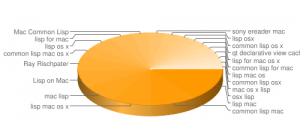I recently needed a spatial index for some data I was working with at work, and decided to rough out both a quad tree and a k-d tree implementation for Qt.
Indexing data spatially is important if you have a lot of objects organized spatially, and need to do queries by an object’s location, rather than a single-dimensional key such as an ID. Qt has a framework for doing this in the context of the QGraphicsFramework, but doesn’t have generalized container classes that index along multiple dimensions — think, for example, of a multi-dimensional QMap.
I implemented the quad tree largely from scratch, looking at wikipedia and a couple implementations such as the one here. My quad tree uses C++ templates to abstract the data type, so you can stick anything in it (as long as it can be put in a QList; the underlying store uses QList for object management). Quad trees come up a lot in collision detection in computer graphics and gaming, where you want to know if an object is close enough to another object to collide, but don’t want to search through lots of objects and do collision detection on each object. It works by recursively subdividing the plane containing the objects, performing additional subdivisions each time a region contains more than a specific number of objects.
I cheated when it came to the k-d tree, because there’s a great C implementation on code.google.com that did precisely what I needed. Because I needed to store QVariants in the k-d tree, I just wrapped the entire C library in a Qt class, making the C code static to my implementation. It’s not quite as sexy as a templated version, because it’ll only store objects you can wrap in a QVariant, but for my application it was enough, and in the future if I have a different kind of object I want to store, it’s easy enough to make it storable as a QVariant, too. k-d trees are more general than quad trees, operating in more dimensions than two as they subdivide the search space.
Neither of these implementations are truly “high performance” — for clarity and ease of debugging, they use Qt’s data structures under the hood, which are fairly performant but not as high performance as managing all the data out of the application’s heap using pointers alone. This is especially true for the find methods, which return copies of the data stored in the trees rather than pointers to the actual data. This is, I believe, correct in my case, where I don’t want to expose the internal structure of my data, and where I’m using Qt classes that use references and copy-on-write semantics anyway. However, if you’re looking to squeeze every last bit of performance from your spatial index, you probably don’t want to start with the code you’ll find here. Nonetheless, for general computational tasks, these should serve you quite well.
You can find both of the implementations and a little standard I/O app for using them here.
